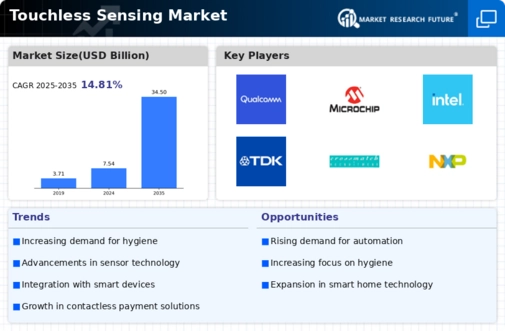Top Industry Leaders in the Touchless Sensing Market

The Competitive Landscape of the Touchless Sensing Market
Across sterile hospital wards, bustling airports, and sleek smart homes, a silent symphony of gestures orchestrates our interactions – the magic of touchless sensing. This dynamic market pulsates with the competitive energy of players vying for control over these invisible conductors of contactless interaction. Unveiling the strategies, crucial factors, and overall landscape of this intricate market is vital for navigating its currents and securing a commanding position.
Some of the Touchless Sensing companies listed below:
- Eyesight Technologies Ltd.
- Microsoft Corporation
- Qualcomm Inc.
- Microchip Technology Inc.
- Intel
- Elliptic Labs Inc.
- CogniVue Corporation
- InvenSense
- Crossmatch
- NXP Semiconductors
Strategies Adopted by Leaders:
- Technological Prowess: Intel RealSense and Microsoft Azure Kinect lead the charge with advanced 3D cameras and sophisticated algorithms, offering exceptional gesture recognition, object tracking, and environmental analysis, catering to demanding needs across diverse applications.
- Vertical Specialization: PointGrab and Leap Motion focus on specific segments like robotics or virtual reality, achieving unmatched expertise and cost-effectiveness within their chosen domains.
- Software and Platform Integration: Google Tango and ARKit offer comprehensive software development kits (SDKs) simplifying integration and accelerating touchless interface development for diverse projects.
- Focus on Security and Privacy: Companies like Elliptic Labs and Infineon Technologies understand the importance of robust security measures and data encryption, prioritizing user privacy and compliance with data protection regulations.
- Partnerships and Collaboration: Open standards and interoperability are key, with players like the OpenXR Forum forging collaborations to ensure broad device compatibility and expand market reach.
Critical Factors for Market Share Analysis:
- Accuracy and Responsiveness: Companies offering touchless systems with precise gesture recognition, minimal latency, and reliable object tracking command premium prices and secure market share by delivering seamless and frustration-free user experiences.
- Adaptability and Environmental Resilience: Systems operating effectively in diverse lighting conditions, withstanding noise and interference, and adapting to different user postures can cater to a wider range of applications and environments, increasing market penetration.
- Data Security and Privacy Protection: Providing robust security features, minimizing data collection, and offering transparent privacy policies is crucial for gaining user trust and building brand loyalty in a privacy-conscious market.
- Software Development Tools and Ease of Integration: Offering readily available SDKs, robust technical documentation, and seamless integration with existing platforms simplifies development and accelerates product launch, attracting developers and expanding the user base.
- Cost Competitiveness and Affordability: Balancing advanced functionalities with an attractive price point is crucial for capturing market share, particularly in price-sensitive segments like consumer electronics and public infrastructure.
New and Emerging Companies:
- Startups like Ultrahaptics and bHaptics: These innovators focus on developing next-generation haptic feedback technologies, allowing users to feel virtual objects and textures, pushing the boundaries of touchless interaction and immersion.
- Academia and Research Labs: Stanford University's Center for Computer Science and the University of Washington's Allen Institute for Brain Science explore disruptive technologies like brain-computer interfaces and neural gesture recognition, shaping the future of how we interact with machines without physical touch.
- Material Science Companies: DuPont and 3M invest heavily in R&D for advanced materials with enhanced touch sensitivity, heat resistance, and self-cleaning properties, enabling the development of durable and hygienic touchless sensors for diverse applications.
Latest Company Updates:
Oct. 25, 2023, Banner Engineering (India) launched the PVS28 parts verification sensor, enabling touchless activation and visual operator guidance for picking, assembly, and fulfillment tasks. The PVS28 simplifies programming and installation with flexible sensing ranges and teachable modes. It incorporates various indicator colors for efficient picking and assembly, while its touchless operation ensures cleanliness and enhances pick speed and accuracy.
Aug.10, 2023, The Land Transport Authority (LTA), Singapore, announced its plan to roll out new touchless push buttons at four pedestrian crossings as part of a trial to assess to use of contactless sensors. These microwave-based sensors will activate the green signal upon waving a hand. This means pedestrians at these crossings only have to wave instead of pushing a button to activate the green signal. The trial will take place over the next six months.
Feb.06, 2023, KEUCO announced the development of a series of touchless taps designed using the IXMO Sensor to respond to increasing hygiene and sustainability concerns. Combining technology with stylish design, the IXMO Sensor series of touchless taps design includes various additional benefits, ensuring easy cleaning methods and a reduced flow rate, thus making it more sustainable.
Mar. 17, 2022, Scientists from Jawaharlal Nehru Centre for Advanced and Scientific Research and co-workers announced an affordable solution that can help develop a low-cost touch-cumproximity sensor called a touchless sensor. DST-Nanomission at the Centre for Nano and Soft Matter Sciences (CeNS) funded this project. The researchers said they aimed at reducing the risk of virus spread, particularly in public places where touchscreens on ATMs, self-service kiosks, and vending machines are inevitable.
